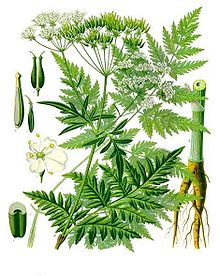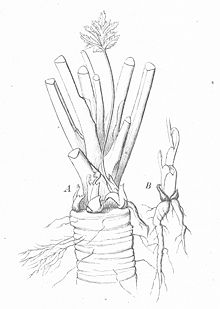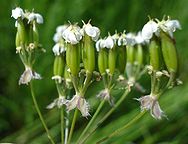- Anthriscus sylvestris
-
Not to be confused with Giant cow parsley.
Anthriscus sylvestris 
Scientific classification Kingdom: Plantae (unranked): Angiosperms (unranked): Eudicots (unranked): Asterids Order: Apiales Family: Apiaceae Genus: Anthriscus Species: A. sylvestris Binomial name Anthriscus sylvestris
Hoffm.Anthriscus sylvestris, known as Cow Parsley, Wild Chervil, Wild Beaked Parsley, Keck, or Queen Anne's lace[1], is a herbaceous biennial or short-lived perennial plant in the family Apiaceae, genus Anthriscus. It is also sometimes called Mother-die (especially in the UK), a name that is also applied to the Common Hawthorn. It is native to Europe, western Asia and northwestern Africa; in the south of its range in the Mediterranean region, it is limited to higher altitudes. It is related to other diverse members of Apiaceae such as parsley, carrot, hemlock and hogweed.
The hollow stem grows to a height of between 60–170 cm, branching to umbels of small white flowers. Flowering time is mid-spring to early summer.
The tripinnate leaves are 15–30 cm long and have a triangular form. The leaflets are ovate and subdivided.
Cow Parsley grows in sunny to semi-shaded locations in meadows and at the edges of hedgerows and woodland. It is a particularly common sight by the roadside. It is sufficiently common and fast-growing to be considered a nuisance weed in gardens. Cow parsley's ability to grow rapidly through rhizomes and to produce large quantities of seeds in a single growing season has made it an invasive species in many areas of the United States. The state of Vermont has listed cow parsley on its "Watch List" of invasive species while Massachusetts and Washington have banned the sale of the plant.
Uses
Warning: Cow Parsley can be mistaken for several similar-looking poisonous plants, among them Poison hemlock and Fool's parsley. Do not rely on Wikipedia alone when identifying plants for consumption.Cow Parsley is considered to be edible, though having a somewhat unpleasant flavour, sharper than Garden Chervil, with a hint of Carrot.
Cow Parsley is rumoured to be a natural mosquito repellent when applied directly to the skin.[citation needed] However cow parsley can be confused with giant cow parsley/giant hogweed (Heracleum mantegazzianum), the sap of which can cause severe burns after coming in contact with the skin.
References
- ^ Mabberley, D.J. (2008). The plant book: A portable dictionary of the vascular plants. Cambridge University Press.
Edible Apiaceae Ajwain • Alepidea peduncularis • Alexanders • Anise • Anthriscus sylvestris • Apium prostratum • Arracacha • Asafoetida • Bunium persicum • Caraway • Carrot • Celeriac • Celery • Centella asiatica • Chaerophyllum bulbosum • Chervil • Cicely • Coriander • Crithmum • Cryptotaenia • Cumin • Daucus pusillus • Dill • Echinophora sibthorpiana • Erigenia bulbosa • Eryngium foetidum • Fennel • Garden Angelica • Ground-elder • Heracleum persicum • Lomatium • Lomatium parryi • Lovage • Masterwort • Oenanthe javanica • Osmorhiza • Parsley • Parsnip • Perideridia • Radhuni • Ridolfia segetum • Sium sisarum
Categories:- Apiaceae
- Edible Apiaceae
- Herbs
- Flora of the Mediterranean
- Flora of Algeria
- Flora of Morocco
- Flora of Ethiopia
- Flora of Kenya
- Flora of Tanzania
- Flora of Uganda
- Flora of South Africa
- Flora of Yemen
- Flora of Iran
- Flora of Iraq
- Flora of Turkey
- Flora of Georgia (country)
- Flora of Russia
- Flora of Mongolia
- Flora of China
- Flora of Japan
- Flora of Korea
- Flora of India
- Flora of Denmark
- Flora of Ireland
- Flora of Norway
- Flora of the United Kingdom
- Flora of Germany
- Flora of Estonia
- Flora of Lithuania
- Flora of Latvia
- Flora of Greece
- Flora of Italy
- Flora of Romania
- Flora of France
- Flora of Portugal
- Flora of Spain
- Invasive plant species
Wikimedia Foundation. 2010.



